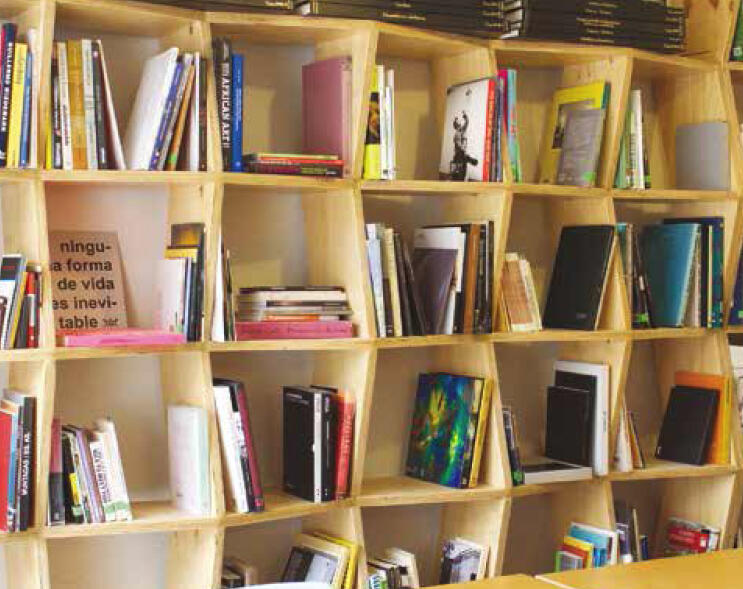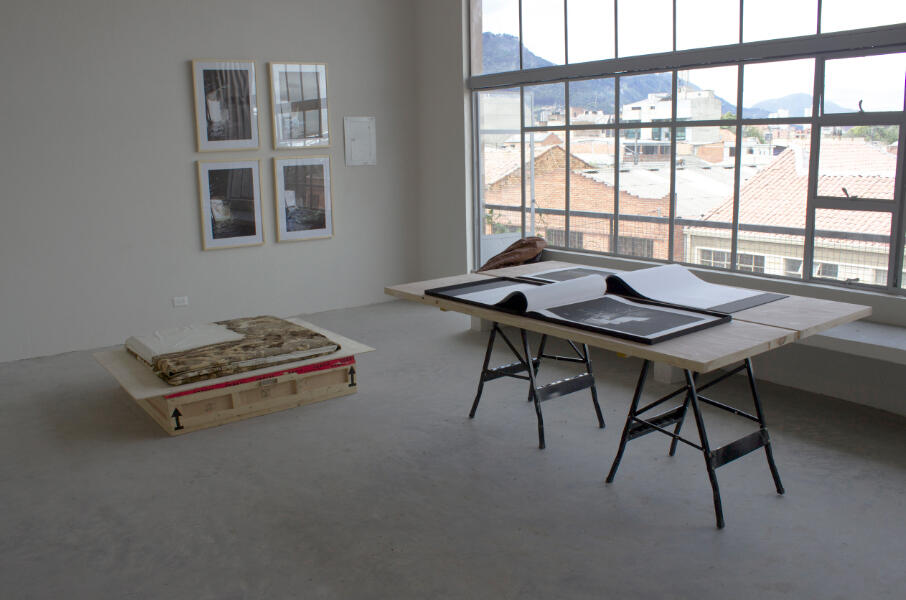_No life form is inevitable/Ninguna forma de vida es inevitable_
Flora: ars + natura, Bogotá
The inaugural exhibition of this space opened by curator José Roca takes its title from a phrase by B.F. Skinner –“No life form is inevitable”- re-updating the notion of self-determination and the legacy of the Botanical Expedition that, in the 18th century, linked together the recognition of natural riches and the dream of political autonomy.

Distancing itself from the oppositions between nature and culture, Flora: ars + natura inserts this binomial in artistic practices and in their relationship with political thinking. The works exhibited connect individual creation and the construction of life forms that constitute resistance niches, territories of a liberating subjectivity.
Roca’s curatorship propitiates the exploration and reconstruction of an inventory of lives that posited ̶ in a way that has been updated by the diverse artistic practices ̶ other forms of existence in harmony with nature, as well as alternative spaces for human relations. It is, in fact, the first version of the Album program which takes “a relevant literary work” for Flora and turns it into a sort of “pre-existing catalogue” of an exhibition. In this case, the core work is Walden or Life in the Woods, the book that Henry David Thoreau wrote when he retired to the forest and built his cabin, in the mid-19th century, in the woods in the neighborhood of Connecticut, the epicenter of American transcendentalists, as a refuge in the face of the intrusive role of the State.
Faced with the heteronomous –that external power that hinders the development of a person’s nature ̶ Thoreau postulated the individual search for “the essential facts of life”, as may be read in the version that artist Kevin Mancera transcribed by hand and illustrated for the exhibition. An exercise which, in turn, evokes the draftsmen of the botanical expedition, and reminds us of the relationship between the hand that re-creates the world and thought generation. In any case, as Roca asserts, this text that extoled civil disobedience and gave rise to Gandhi and Luther King’s peaceful resistance, “is in the origin of peaceful dissidence everywhere in the world, from movements such as Occupy Wall Street or Los indignados, to the current protests concerning the way in which we are governed.”
Continuing with the Walden genealogy that inspired the real estate project Walden 7, self-managed and conceived by the Catalonian architect Ricardo Bofill and the Taller de Arquitectura group, Luis Fernando Ramírez created a version of their model in plastic and honey ̶ hanging in the terrace like a bee-hive ̶ thus evoking instances that gave rise to alternative social spaces for creation and coexistence.
In a parallel way, artist and architect Marjetica Potrč takes the walls to trace on them drawings and diagrams of communities that have isolated themselves in the Amazon region to attempt utopian projects. Her manifesto restates – as does the whole exhibition – the fact that the exhaustion of the great narratives that were imposed on us does not prevent the existence of interstices in which individuals or small groups attempt to live alternative lives.
Adjacent to this work, Ana María Rueda mounted on the wall apparently abstract photographic prints on rice paper featuring satellite maps of the growing devastation in the Amazon forest. “Places where there is nothing left,” she says. Voids that bring to mind the gradual disappearance of the fantasy worlds in Michael Ende’s The Neverending Story, as they cease to be imagined or narrated.
As a live performance and persistence-resistance exercise, María Angélica Medina resumed the weaving of the gigantic sphere that, for decades, she has built as she holds innumerable conversations with people who sit and talk to her while she knits her endless skein in her sitting-room or in some exhibition space. “A therapy” that links her to people and to everyday life, warped with disobedience to the dominant tendencies. Every seven conversations, this artist who says she “only knows how to knit,” changes her needle.
In another room in Flora, the installation by María Isabel Rueda ̶ a documentation that evokes the work and the life experience of artist Norman Mejía, literally secluded in the castle he built for himself in Puerto Colombia for his hallucinated figures ̶ engaged in a dialogue with that of Milena Bonilla ̶ El fin del mundo será silencioso (The end of the world will be silent ) ̶ fuse, creating an adjacent poetics that shows resistance paths opened by isolation and mediated by the energy of a time open to renovation. Whether it be through the potency of future imagination or through the memory of vital gestures that become updated. Not for nothing Rueda has chosen to live in the same town as Mejía, in order “to live a life governed by their own rules”, according to Roca.
The artist duo Gómez&González reappropriated the cabin in Spain where the Hermit of Tarifa had lived by capturing the essence of the place through the technique of frottage on the walls (memory of the skin of the house and trace of time). In turn, they transformed its interior into a camera obscura to bring inside the landscape around it and fix its projection by means of a technique from the past. The artist collective Maski subverted in a different way the frontier between external architecture and external space: it filmed the ruins of a house through a shot in which the only movement is that of the unexpected smoke coming out of the chimney, which activates both the open sky and the walls exposed to the natural environment. Daniel Acosta’s beautiful bookcase with octagonal biomorphic niches that surrounded the video will overflow towards Flora’s external patio.
Juan Leal Ruiz has made a parallel transfer in the website lealruiz.com, where after a decade of seclusion in his world, he shows his personal life in public as a way of openly expressing his singularity and trying to “personalize the true direction of the interaction of contemporary art.” Guy Ben-Ner’s video, in which the artist is Crusoe at home in his kitchen, shows the poetic tension between the freedom of isolation and the urgency of interaction.
Melanie Smith, in collaboration with Rafael Ortega, presents Xilitla, a film that recovers the house that the British millionaire poet Edward James – portrayed by Magritte – built for himself “in the heart of the Mexican rainforest,” where he chose to live surrounded by a surrealist art collection and “the sound of green”. Gabriel Silva’s inclusion of volcanoes and nocturnal landscapes featured in “the colors that remain in the palette at the end of the day” exposes us both to the power of interior spaces and to the collective memory of art, because it is no longer possible at present to watch an erupting volcano without immediately associating it with Dr. Atl, the lord of volcanoes, who on one occasion, fleeing from the Mexican authorities, took refuge in a convent inhabited by ghostly presences. Luis Hernando Giraldo’s landscape-installation evokes both the geographic space of childhood as a map of historical violence with border tensions between redemption and the shadow of death.
The cabin that the terrorist Unabomber built in another American forest to plan actions that would undermine, through violence, the progress that he considered linked to “a de-humanizing technology”, is invoked as a metaphor for the utopias that turned into nightmares in the 20th century. Alberto Lezaca synthesized the cabin of the radical neoludist in an architectonic structure that he exhibited together with a fake axe and inserted digitally in other woods by means of electronic technology. The irony resides in the fact that he reifies Unabomber’s habitat using the technology the terrorist aspired to destroy, giving way to a critical re-visiting of his figure that Daniel Joseph Martínez undertakes, in turn, in a series of hybrid architectonic planes.
In the works exhibited temporally in No life form is inevitable, as well as in those that will be permanently displayed in Flora – Miguel Ángel Roca’s meteorite embedded in the window, a light material invested, however, with an allusion to erosive trades, or Juan Carlos Delgado’s poetic ice rosebush, cyclically reborn to the rhythm of the seasons in the patio – nature and art interweave as porous and inseparable spaces of individual and community life. The works transport us to the wide margin of freedom that our imagination can open in the biopolitical sphere. Not for nothing, the vision of Tomás Saraceno’s floating garden in a transparent sphere evokes the possibility of reinventing the perceptions of space as ways of inhabiting the world.






